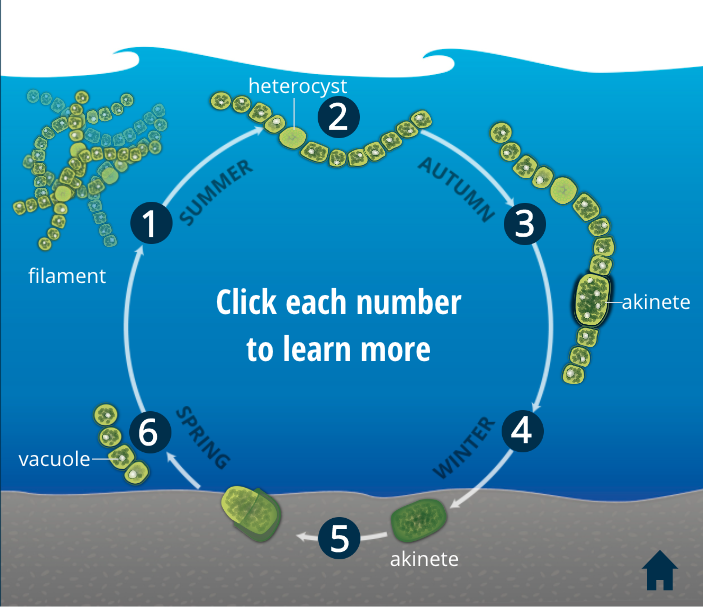Microcystis
- Most common bloom-forming genus of freshwater cyanobacteria
- Found on every continent except Antarctica
- Blooms may lead to:
- Blockage of drinking water supply
- Removal of dissolved oxygen
- Intensive water treatment
- Substantial economic costs
- Produces microcystins that cause poisoning in mammals
Morphology & Ecology
For the most part, identification of these species relies on molecular techniques rather than morphological features. When observed under a microscope, these tiny oval prokaryotes (cells lacking organelles) are about 0.3-0.4 μm, appear uniformly green, and are frequently found in long chains, much like many other cyanobacteria. Cells are characterized by small gas filled vesicles, which allow them to stay afloat on the surface of the water and form large floating colonies that are visible with the naked eye. This not only allows the cells to have all the access to light they might need for photosynthesis, but also allows MIcrocystis to dominate the surface and block out light for other species within the water.
MIcrocystis species are greatly influenced by nitrogen and phosphorous ratios as they are extremely efficient at nutrient uptake and therefore thrive in eutrophic waters. Microcystis life cycle and growth is closely linked to temperature. Peak blooms often occur during the warmest summer months and then drop off as temperatures cool. During cold winter months, they become dormant in the sediments as a thicker walled akinete where they can remain for extended periods of time.
Impacts & Toxicity
Microcystis can produce neurotoxins and hepatotoxins, such as microcystin and cyanopeptolin, that are referred to as cyanotoxins. Although, strains within these species can vary dramatically from highly toxic to not toxic at all and toxicity can even change over the course of a bloom due to fluctuation in nitrogen levels. Because of this variability in toxicity, assessing harm and creating health advisories is challenging since it is dependent on toxin concentration rather than the specific species that are present. When these toxic species form blooms, there are often associated cyanotoxin poisonings of local fish, wildlife, pets, stock, and even humans. Heath impacts can vary from headaches, sore throat, gastrointestinal issues, blistering around the mouth, and pneumonia or in rare instances even death. Most often, exposure to cyanotoxins comes from drinking contaminated water or by inhaling aerosols near blooms. Toxic cyanobacteria outbreaks have occurred in every state within the U.S.
Resources & References
Research Articles
- Harke, M. J., Steffen, M. M., Gobler, C. J., Otten, T. G., Wilhelm, S. W., Wood, S. A., & Paerl, H. W. (2016). A review of the global ecology, genomics, and biogeography of the toxic cyanobacterium, Microcystis spp. Harmful Algae, 54, 4-20.
- Xiao, M., Li, M., & Reynolds, C. S. (2018). Colony formation in the cyanobacterium Microcystis. Biological Reviews, 93(3), 1399-1420.

Distribution in the US
Cyanobacteria HABs have been documented in all 50 states with the most prevalent and problematic cyanobacteria being Microcystis aeruginosa. This algae has caused many states to issue health advisories related to their blooms. The majority of impacts in the U.S. have included taste-and-odor problems in drinking water and aquaculture resources, animal deaths, and reduced recreational opportunities.



